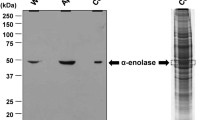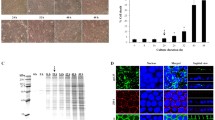Abstract
Tamm-Horsfall protein (THP) is thought to protect against calcium oxalate monohydrate (COM) stone formation by inhibiting COM aggregation. Several studies reported that stone formers produce THP with reduced levels of glycosylation, particularly sialic acid levels, which leads to reduced negative charge. In this study, normal THP was treated with neuraminidase to remove sialic acid residues, confirmed by an isoelectric point shift to higher pH. COM aggregation assays revealed that desialylated THP (ds-THP) promoted COM aggregation, while normal THP inhibited aggregation. The appearance of protein aggregates in solutions at ds-THP concentrations ≥1 μg/mL in 150 mM NaCl correlated with COM aggregation promotion, implying that ds-THP aggregation induced COM aggregation. The aggregation-promoting effect of the ds-THP was independent of pH above its isoelectric point, but was substantially reduced at low ionic strength, where protein aggregation was much reduced. COM aggregation promotion was maximized at a ds-THP to COM mass ratio of ~0.025, which can be explained by a model wherein partial COM surface coverage by ds-THP aggregates promotes crystal aggregation by bridging opposing COM surfaces, whereas higher surface coverage leads to repulsion between adsorbed ds-THP aggregates. Thus, desialylation of THP apparently abrogates a normal defensive action of THP by inducing protein aggregation, and subsequently COM aggregation, a condition that favors kidney stone formation.






Similar content being viewed by others
References
Bayer ME (1964) An electron microscope examination of urinary mucoprotein and its interaction with influenza virus. J Cell Biol 21:265–274
Benkovic J, Furedi-Milhofer H, Hlady V, Cvoriscec D, Stavljenic-Rukavina A (1995) Effect of Tamm-Horsfall protein on calcium oxalate precipitation. Eur J Clin Chem Clin Biochem 33:705–710
Bichler K, Mittermuller B, Strohmaier WL, Feil G, Eipper E (1999) Excretion of Tamm-Horsfall protein in patients with uric acid stones. Urol Int 62:87–92
Boeve ER, Cao LC, de Bruijn WC, Robertson WG, Romijn JC, Schroder FH (1994) Zeta potential distribution on calcium oxalate crystal and Tamm-Horsfall protein surface analyzed with Doppler electrophoretic light scattering. J Urol 152:531–536
Boyce WH, King JS Jr (1963) Present concepts concerning the origin of matrix and stones. Ann NY Acad Sci 104:563–578
Boyce WH, Swanson M (1955) Biocolloids of urine in health and in calculous disease. II. Electrophoretic and biochemical studies of a mucoprotein insoluble in molar sodium chloride. J Clin Invest 34:1581–1589
Canales BK, Anderson L, Higgins L, Slaton J, Roberts KP, Liu N, Monga M (2008) Second prize: comprehensive proteomic analysis of human calcium oxalate monohydrate kidney stone matrix. J Endourol 22:1161–1167
Cao LC, Deng G, Boeve ER, de Bruijn WC, de WR, Verkoelen CF, Romijn JC, Schroder FH (1996) Zeta potential measurement and particle size analysis for a better understanding of urinary inhibitors of calcium oxalate crystallization. Scanning Microsc 10:401–411
Cavallone D, Malagolini N, Serafini-Cessi F (2001) Mechanism of release of urinary Tamm-Horsfall glycoprotein from the kidney GPI-anchored counterpart. Biochem Biophys Res Commun 280:110–114
Clyne DH, Kant KS, Pesce AJ, Pollak VE (1979) Nephrotoxicity of low molecular weight serum proteins: physicochemical interactions between myoglobin, hemoglobin, Bence-Jones proteins and Tamm-Horsfall mucoprotein. Curr Probl Clin Biochem 9:299–308
Clyne DH, Pesce AJ, Thompson RE (1979) Nephrotoxicity of Bence Jones proteins in the rat: importance of protein isoelectric point. Kidney Int 16:345–352
De Yoreo JJ, Qiu SR, Hoyer JR (2006) Molecular modulation of calcium oxalate crystallization. Am J Physiol Renal Physiol 291:F1123–F1131
Finlayson B (1978) Physicochemical aspects of urolithiasis. Kidney Int 13:344–360
Ganter K, Bongartz D, Hesse A (1999) Tamm-Horsfall protein excretion and its relation to citrate in urine of stone-forming patients. Urology 53:492–495
Gokhale JA, Glenton PA, Khan SR (1997) Biochemical and quantitative analysis of Tamm-Horsfall protein in rats. Urol Res 25:347–354
Grover PK, Resnick MI (1995) Evidence for the presence of abnormal proteins in the urine of recurrent stone formers. J Urol 153:1716–1721
Hallson PC, Choong SK, Kasidas GP, Samuell CT (1997) Effects of Tamm-Horsfall protein with normal and reduced sialic acid content upon the crystallization of calcium phosphate and calcium oxalate in human urine. Br J Urol 80:533–538
Hallson PC, Rose GA (1979) Uromucoids and urinary stone formation. Lancet 1:1000–1002
Hess B, Nakagawa Y, Coe FL (1989) Inhibition of calcium oxalate monohydrate crystal aggregation by urine proteins. Am J Physiol 257:F99–F106
Hess B, Nakagawa Y, Parks JH, Coe FL (1991) Molecular abnormality of Tamm-Horsfall glycoprotein in calcium oxalate nephrolithiasis. Am J Physiol 260:F569–F578
Hession C, Decker JM, Sherblom AP, Kumar S, Yue CC, Mattaliano RJ, Tizard R, Kawashima E, Schmeissner U, Heletky S (1987) Uromodulin (Tamm-Horsfall glycoprotein): a renal ligand for lymphokines. Science 237:1479–1484
Hoyer JR, Seiler MW (1979) Pathophysiology of Tamm-Horsfall protein. Kidney Int 16:279–289
Huang ZQ, Sanders PW (1995) Biochemical interaction between Tamm-Horsfall glycoprotein and Ig light chains in the pathogenesis of cast nephropathy. Lab Invest 73:810–817
Jaggi M, Nakagawa Y, Zipperle L, Hess B (2007) Tamm-Horsfall protein in recurrent calcium kidney stone formers with positive family history: abnormalities in urinary excretion, molecular structure and function. Urol Res 35:55–62
Jovine L, Qi H, Williams Z, Litscher E, Wassarman PM (2002) The ZP domain is a conserved module for polymerization of extracellular proteins. Nat Cell Biol 4:457–461
Knorle R, Schnierle P, Koch A, Buchholz NP, Hering F, Seiler H, Ackermann T, Rutishauser G (1994) Tamm-Horsfall glycoprotein: role in inhibition and promotion of renal calcium oxalate stone formation studied with Fourier-transform infrared spectroscopy. Clin Chem 40:1739–1743
Kobayashi K, Fukuoka S (2001) Conditions for solubilization of Tamm-Horsfall protein/uromodulin in human urine and establishment of a sensitive and accurate enzyme-linked immunosorbent assay (ELISA) method. Arch Biochem Biophys 388:113–120
Konya E, Amasaki N, Umekawa T, Iguchi M, Kurita T (2002) Influence of urinary sialic acid on calcium oxalate crystal formation. Urol Int 68:281–285
Lieske JC, Toback FG, Deganello S (2001) Sialic acid-containing glycoproteins on renal cells determine nucleation of calcium oxalate dihydrate crystals. Kidney Int 60:1784–1791
Malek RS, Boyce WH (1973) Intranephronic calculosis: its significance and relationship to matrix in nephrolithiasis. J Urol 109:551–555
McQueen EG (1966) Composition of urinary casts. Lancet 1:397–398
McQueen EG, Engel GB (1966) Factors determining the aggregation of urinary mucoprotein. J Clin Pathol 19:392–396
Melick RA, Quelch KJ, Rhodes M (1980) The demonstration of sialic acid in kidney stone matrix. Clin Sci (Lond) 59:401–404
Merchant ML, Cummins TD, Wilkey DW, Salyer SA, Powell DW, Klein JB, Lederer ED (2008) Proteomic analysis of renal calculi indicates an important role for inflammatory processes in calcium stone formation. Am J Physiol Renal Physiol 295:F1254–F1258
Mo L, Liaw L, Evan AP, Sommer AJ, Lieske JC, Wu XR (2007) Renal calcinosis and stone formation in mice lacking osteopontin, Tamm-Horsfall protein, or both. Am J Physiol Renal Physiol 293:F1935–F1943
Nakagawa Y, Abram V, Parks JH, Lau HS, Kawooya JK, Coe FL (1985) Urine glycoprotein crystal growth inhibitors. Evidence for a molecular abnormality in calcium oxalate nephrolithiasis. J Clin Invest 76:1455–1462
Pennica D, Kohr WJ, Kuang WJ, Glaister D, Aggarwal BB, Chen EY, Goeddel DV (1987) Identification of human uromodulin as the Tamm-Horsfall urinary glycoprotein. Science 236:83–88
Porter KR, Tamm I (1955) Direct visualization of a mucoprotein component of urine. J Biol Chem 212:135–140
Prado MJ, Nicastri AL, Costa PL, Rockman T, Tersariol IL, Nader HB, Barros RT, Prado EB (1997) The renal and hepatic distribution of Bence Jones proteins depends on glycosylation: a scintigraphic study in rats. Braz J Med Biol Res 30:865–872
Pragasam V, Kalaiselvi P, Subashini B, Sumitra K, Varalakshmi P (2005) Structural and functional modification of THP on nitration: comparison with stone formers THP. Nephron Physiol 99:28–34
Qiu SR, Wierzbicki A, Orme CA, Cody AM, Hoyer JR, Nancollas GH, Zepeda S, De Yoreo JJ (2004) Molecular modulation of calcium oxalate crystallization by osteopontin and citrate. Proc Natl Acad Sci USA 101:1811–1815
Reinhart HH, Obedeanu N, Walz D, Sobel JD (1989) A new ELISA method for the rapid quantification of Tamm-Horsfall protein in urine. Am J Clin Pathol 92:199–205
Robertson WG, Peacock M (1972) Calcium oxalate crystalluria and inhibitors of crystallization in recurrent renal stone-formers. Clin Sci 43:499–506
Romero MC, Nocera S, Nesse AB (1997) Decreased Tamm-Horsfall protein in lithiasic patients. Clin Biochem 30:63–67
Ronco P, Brunisholz M, Geniteau-Legendre M, Chatelet F, Verroust P, Richet G (1987) Physiopathologic aspects of Tamm-Horsfall protein: a phylogenetically conserved marker of the thick ascending limb of Henle’s loop. Adv Nephrol Necker Hosp 16:231–249
Rose GA, Sulaiman S (1982) Tamm-Horsfall mucoproteins promote calcium oxalate crystal formation in urine: quantitative studies. J Urol 127:177–179
Rose MB (1975) Renal stone formation. The inhibitory effect of urine on calcium oxalate precipitation. Invest Urol 12:428–433
Schnierle P (1995) A simple diagnostic method for the differentiation of Tamm-Horsfall glycoproteins from healthy probands and those from recurrent calcium oxalate renal stone formers. Experientia 51:1068–1072
Schnierle P, Hering F, Seiler H (1996) Isoelectric focusing of Tamm-Horsfall glycoproteins: a simple tool for recognizing recurrent calcium oxalate renal stone formers. Urol Res 24:79–82
Scurr DS, Robertson WG (1986) Modifiers of calcium oxalate crystallization found in urine. III. Studies on the role of Tamm-Horsfall mucoprotein and of ionic strength. J Urol 136:505–507
Serafini-Cessi F, Bellabarba G, Malagolini N, Dall’Olio F (1989) Rapid isolation of Tamm-Horsfall glycoprotein (uromodulin) from human urine. J Immunol Methods 120:185–189
Serafini-Cessi F, Monti A, Cavallone D (2005) N-Glycans carried by Tamm-Horsfall glycoprotein have a crucial role in the defense against urinary tract diseases. Glycoconj J 22:383–394
Sheng X, Jung T, Wesson JA, Ward MD (2005) Adhesion at calcium oxalate crystal surfaces and the effect of urinary constituents. Proc Natl Acad Sci USA 102:267–272
Sheng X, Ward MD, Wesson JA (2005) Crystal surface adhesion explains the pathological activity of calcium oxalate hydrates in kidney stone formation. J Am Soc Nephrol 16:1904–1908
Stevenson FK, Cleave AJ, Kent PW (1971) The effect of ions on the viscometric and ultracentrifugal behaviour of Tamm-Horsfall glycoprotein. Biochim Biophys Acta 236:59–66
Sumitra K, Pragasam V, Sakthivel R, Kalaiselvi P, Varalakshmi P (2005) Beneficial effect of vitamin E supplementation on the biochemical and kinetic properties of Tamm-Horsfall glycoprotein in hypertensive and hyperoxaluric patients. Nephrol Dial Transplant 20:1407–1415
Trewick AL, Rumsby G (1999) Isoelectric focusing of native urinary uromodulin (Tamm-Horsfall protein) shows no physicochemical differences between stone formers and non-stone formers. Urol Res 27:250–254
UniProt (2008) The universal protein resource (UniProt). Nucleic Acids Res 36:D190–D195
van Aswegen CH, van der Merwe CA, du Plessis DJ (1990) Sialic acid concentrations in the urine of men with and without renal stones. Urol Res 18:29–33
van Rooijen JJ, Voskamp AF, Kamerling JP, Vliegenthart JF (1999) Glycosylation sites and site-specific glycosylation in human Tamm-Horsfall glycoprotein. Glycobiology 9:21–30
Verkoelen CF, Van Der Boom BG, Kok DJ, Romijn JC (2000) Sialic acid and crystal binding. Kidney Int 57:1072–1082
Webber D, Radcliffe CM, Royle L, Tobiasen G, Merry AH, Rodgers AL, Sturrock ED, Wormald MR, Harvey DJ, Dwek RA, Rudd PM (2006) Sialylation of urinary prothrombin fragment 1 is implicated as a contributory factor in the risk of calcium oxalate kidney stone formation. FEBS J 273:3024–3037
Wesson JA, Ganne V, Beshensky AM, Kleinman JG (2005) Regulation by macromolecules of calcium oxalate crystal aggregation in stone formers. Urol Res 33:206–212
Wesson JA, Ward MD (2007) Pathological Biomineralization of Kidney Stones. Elements 3:415–421
Wiggins RC (1987) Uromucoid (Tamm-Horsfall glycoprotein) forms different polymeric arrangements on a filter surface under different physicochemical conditions. Clin Chim Acta 162:329–340
Williams J, Marshall RD, van HH, Vliegenthart JF (1984) Structural analysis of the carbohydrate moieties of human Tamm-Horsfall glycoprotein. Carbohydr Res 134:141–155
Acknowledgments
The authors thank Dr. Brian K. Olmsted for helpful discussions and Dr. William J. Zachowicz for performing the electrophoretic mobility (zeta potential) measurements reported in this study. This study was supported by the Veterans Affairs Merit Review Program (9305), the National Institutes of Health (NIDDK R01-DK068551), the Jacob Lemann Jr. Endowment Grant from the Medical College of Wisconsin, and the NYU Molecular Design Institute.
Author information
Authors and Affiliations
Corresponding authors
Electronic supplementary material
Below is the link to the electronic supplementary material.
Rights and permissions
About this article
Cite this article
Viswanathan, P., Rimer, J.D., Kolbach, A.M. et al. Calcium oxalate monohydrate aggregation induced by aggregation of desialylated Tamm-Horsfall protein. Urol Res 39, 269–282 (2011). https://doi.org/10.1007/s00240-010-0353-7
Received:
Accepted:
Published:
Issue Date:
DOI: https://doi.org/10.1007/s00240-010-0353-7




